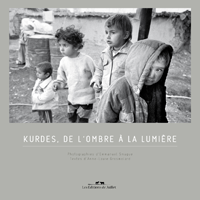Emmanuel Smague
|
Photographs do not forget a people who have been forgotten. Nor, in Emmanuel Smague’s work, do the photographs betray them. His portraits of ethnic and social minorities assert the uniqueness of all individuals while also bringing into relief the particular shared customs of a region or group. His photographs also give the impression of having been taken by a close family member. In the tradition of humanism, from which Smague works, we are all closer than we realize. But he seems to have uncanny access—deriving, perhaps, from sympathy and compassion—into the lives of other people. Strangers begin to seem like friends. Distant regions, like home. And photography, like truth. Your photographs are often surprisingly intimate portraits of people. How do you establish such close relationships with your subjects? I must admit that taking pictures of people I don’t know would not interest me so much, and so I use only one lens, the 35mm. With a zoom lens, I would feel as if I were ‘stealing’ something from them. I like to take my time before doing anything. Setting up my camera is not such a priority for me—establishing a relationship with the person I’m shooting is. What lessons or wisdom have you learned from your subjects? Respect, before all else. What have been some highlights of your photographic journeys? I can cite three that really resonate for me. Iraqi Kurdistan—three trips into the heart of that history, to encounter refugees in their own land. The nomads of Central Asia and Mongolia, among whom ancestral traditions persist. And finally, the street kids of Kathmandu (unreleased pictures), a photographic work made possible by an NGO and those kids, who always gave me respect. How do you choose your journeys? After 13 years of having traveled without taking photos, I began choosing journeys in 2005 directly related to photographic subject matter: Trans-Siberia; refugee camps in Iraqi Kurdistan; the nomadic people of Central Asia, Mongolia and Ladakh (India); the chiffonniers of Cairo; the Chernobyl region; and the street kids of Kathmandu. If the eyes of the cameraman and the technique are so important in realizing an image, then all advance work concerning your choice of a theme and your manner of approach seems utterly essential to me. Have you encountered any dangers on the road? A few small scares without any consequences. Elementary precautions go a long way. What, in your own opinion, defines your style? My photographic work is infused with the tradition of humanism. To me, a photo needs to tell a story. I also place great importance on the composition of the image. What other photographers or artists have guided you or provided inspiration? Let me mention the main ones: Bresson, Koudelka, Salgado and Agoudjian. Their outstanding humanist work has always inspired me. You seem to shoot ethnic groups that have been disenfranchised by their state and/or disadvantaged by either geography or political circumstances. What motivates you in photographing such people? Is there a message you want to convey? The message is clear. In illustrating a quote by Milan Kundera, “memory does not film, memory photographs,” my photographs try to capture people’s attention, give eternal witness to chapters of human stupidity and inscribe collective memory so that people never forget. What brought you to photography? I needed to invent a pretext for discovering the unusual, including people, thousands of kilometers from home—or just steps away. Has the camera become an essential tool? What is essential, without a doubt, is experiencing the present moment, opening one’s eyes, even if it does not result in an image. The image makes it possible to communicate and share an emotion, to make the person who looks at it dream or imagine things. However, having a taste of reality, of all you can see, smell, listen to or even touch, is much more enriching than a photograph, which is a pale reflection of reality. Images also allow us to remember moments of our lives that would become lost otherwise. But the strongest moments cannot be forgotten. In fact, photography seems to feed from the mere need or desire to create. What lies ahead for you? At the moment, I am a professor of music, but I hope one day to completely support myself as a photographer, working, for example, for an agency somewhere. |
写真は過去の人たちの真の姿を我々に伝え続ける。エマニュエル・スマーグの作品においては名も無い人たちの真の姿、彼らの本質、が見事に表現されていて、少数民族ひとりひとりの個性とその地域の風習を浮き彫りにしている。 彼が撮った写真からは、家族が撮ったような打ち解けた印象も受ける。スマーグが重視しているヒューマニズムというものの中では見ず知らずの人でも意外と近しいものであるようだ。しかし彼の場合、被写体に対する深い思いやりのおかげで彼らにとても自然に近づいていける能力を持っているように思える。彼にとっては初めて会う人もみな友達。遠い異国の地もまるで故郷のよう。そして彼の写真は真実そのものを写しているようだ。 あなたが撮る写真は被写体となっている人々の表情を非常に生き生きと映し出していて、作品によってはまるで肖像写真のようでさえありますが、どうやったらそんなに被写体に接近できるものなのでしょう? 実は、知らない人の写真を撮ること自体にそんなに興味があるわけではありません。使うレンズも1種類、35mmしか使いません。ズームレンズを使うことは何か盗撮をしているような罪悪感がありますから。写真を撮るまでには充分時間を掛けますよ。ただし、機材のセットアップよりも被写体との関係構築により多くの時間を使います。 被写体から学んだことは何かありますか? 相手を敬う気持ちです。 今までの旅で最も印象に残っているのは? クルド人の歴史を訪ねて現地に赴き、自国で難民となっている人々と出会った3回の旅。古くから伝わる風習を残している中央アジアとモンゴルの遊牧民との出会い。そして、カトマンズのストリートキッズ達と出会った旅も印象に残っています。カトマンズではNGOの協力も得て仕事ができました。 行き先を決める基準は何ですか? 仕事とは関係無く自由な旅を13年間続けた後、2005年から被写体を意識した旅をするようになりました。シベリア横断、クルド人の難民キャンプ、中央アジア、モンゴル、ラダク(インド)の遊牧民、カイロの貧しい人々、チェルノブイリ、カトマンズのストリートキッズ達・・・これらが今までのテーマでした。写真を撮る側の観察眼や技術的なものが重要であるならば、行き先やテーマの選定も作品の質を大きく左右しますし、被写体にどう接するかということも大変重要な要素となります。 危険な目に会ったことは? ちょっとした事件は何度かありましたが、大事に至ったことはありません。身を守る基本的な心構えがあれば大丈夫です。 あなたのスタイルを特徴づけているものはなんでしょうか? 私の作風はヒューマニズムに大きく影響されています。そして写真は何かを訴えるものでなければならないと思っています。また、写真の構図にはとても気を使っています。 影響を受けた写真家、芸術家は? ブレッソン、クーデルカ、サルガド、アグージャンなどです。彼らのヒューマニズムに根差した作風にはいつも刺激を受けています。 国から公民権をはく奪された人々や、土地を追われた不幸な人々などを多く撮っていますが、そこにはどんなメッセージが込められているのですか? 作家ミラン・クンデラは「記憶は映像的なものではなく写真に近い」と言っています。私の作品は人々の関心を高め、人間の愚かさの証明を目に見える形で残し、その記憶を写真に刻み込むことによって観る人々の心に残すことを目的としています。 写真を始めたきっかけは? 被写体が遠い異国の地にあろうと、すぐ近くにあろうと、何か普通でない事柄、物事、人たちを訪ね歩く理由を私は探していました。何より大切なことは今この瞬間を実際に経験し直視することです。写真という媒体を通じてイメージを共有することによって心が通じ合い、感情の共有が可能になりますが、実際に現場に行って現実を直視し、匂いを嗅ぎ、音を聞き、時には手で触ってみることが写真よりもはるかに意義深いのです。写真は現実に起こったことの残像にすぎませんから。 写真は人間の記憶を呼び覚まさせてくれます。しかし、強烈な体験はいつまでも心に残ります。結局のところ、写真は単に必要性を満たすもの、あるいは創作意欲を満足させるためのものでしかありません。 今後の予定などは? 今は写真家であり音楽学科の教授でもありますが、将来的には例えばどこかの機関の専属カメラマンとして働くなどして、写真だけでやっていきたいと思っています。 和訳–徳畑謙二 |
|
|
Emmanuel Smague’s book:
Kurdes, de l’ombre à la lumière To order: www.editionsdejuillet.com To order prints, please refer to |









